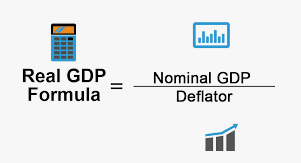Gross Domestic Product (GDP) is a fundamental measure of a country’s economic performance, representing the total value of all goods and services produced within its borders over a specified period. Real GDP, on the other hand, adjusts GDP for inflation, providing a more accurate reflection of economic growth over time. Understanding how to calculate real GDP is essential for policymakers, economists, investors, and businesses seeking to analyze and interpret economic trends. In this comprehensive guide, we’ll explore five key points to help you calculate real GDP effectively and gain insights into the health of an economy.
1. Obtain Nominal GDP Data:
The first step in calculating real GDP is to obtain data on nominal GDP for the period of interest. Nominal GDP represents the current market value of all final goods and services produced within a country’s borders without adjusting for inflation. This data is typically reported by government agencies such as the Bureau of Economic Analysis (BEA) in the United States or national statistical offices in other countries.
2. Obtain Price Index Data:
Next, obtain data on a suitable price index that measures changes in the overall price level of goods and services in the economy over time. The most commonly used price index for calculating real GDP is the Consumer Price Index (CPI) or the GDP deflator. The CPI measures changes in the prices of a basket of consumer goods and services, while the GDP deflator measures changes in the prices of all domestically produced goods and services.
3. Calculate the GDP Deflator:
To calculate the GDP deflator, divide nominal GDP by real GDP and multiply by 100. The GDP deflator represents the ratio of nominal GDP to real GDP, expressed as a percentage. By comparing nominal GDP to real GDP, the GDP deflator adjusts GDP for inflation and provides a measure of the overall price level of goods and services produced in the economy.
4. Calculate Real GDP:
To calculate real GDP, divide nominal GDP by the GDP deflator and multiply by 100. The resulting value represents real GDP, which reflects the value of goods and services produced in the economy adjusted for changes in the overall price level. Real GDP provides a more accurate measure of economic output and growth by accounting for inflationary effects on GDP over time.
5. Interpret Real GDP Data:
Once you have calculated real GDP, analyze the data to gain insights into the performance and health of the economy. Changes in real GDP over time can indicate periods of economic growth or contraction, as well as fluctuations in inflationary pressures. Real GDP per capita, which adjusts real GDP for population growth, provides a measure of economic well-being and living standards for the population.
Conclusion:
Calculating real GDP is essential for assessing and interpreting economic trends, providing policymakers, economists, investors, and businesses with valuable insights into the health and performance of an economy. By following the five key points outlined in this guide—obtaining nominal GDP data, obtaining price index data, calculating the GDP deflator, calculating real GDP, and interpreting real GDP data—you can calculate real GDP effectively and analyze economic trends with accuracy and precision. Real GDP serves as a crucial indicator of economic growth and development, guiding decision-making processes and informing policy responses to economic challenges. So next time you’re analyzing economic data or monitoring macroeconomic trends, remember these steps to calculate real GDP and gain a deeper understanding of the dynamics shaping the economy.
